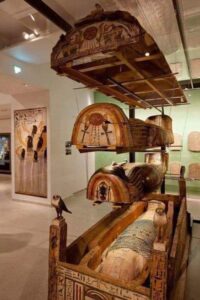Ancient Egyptian coffins are among the most prominent cultural artifacts, not only for their craftsmanship but also for the deep cultural significance they carry, reflecting the Egyptians’ beliefs in life, death, and the afterlife. Each coffin was not just a container for the deceased’s body but a protective means to safeguard the soul from dangers in the afterlife, serving as a “gate” to guide the departed into eternal life.
Intricate Craftsmanship and Artistic Techniques
One of the most striking features of ancient Egyptian coffins is the combination of intricate painting and sculpture. The wooden layers of the coffins were often covered in vibrant scenes from Egyptian mythology, depicting gods, protective spirits, and sacred rituals. These detailed scenes were not only decorative but also carried deep symbolic meanings aimed at ensuring divine protection and a safe journey for the deceased. The images on the coffins often portrayed gods, funeral rituals, or sacred objects that the departed would carry with them.
These images were not merely works of art; they were prayers and invocations to the gods, hoping to protect the soul and facilitate a safe journey to the afterlife.

The Cultural Function and Significance of Coffins
Ancient Egyptian coffins, particularly those with multiple layers, served not only to protect the body but also as symbols of spiritual safeguarding and protection by supernatural forces. These multi-layered coffins reflect the elaborate burial rituals of the time, demonstrating the belief that death was not an end but a transition to a new phase of existence.
Such elaborate burial practices were reserved for the elite of Egyptian society, such as nobles or high-ranking officials. For these individuals, the coffin was not only a resting place for the body but also a vessel that helped the soul navigate through the trials of the afterlife. This practice highlights the Egyptian belief that death was not an end but a passage to another form of existence, where the soul would continue to live under the protection of divine forces.

Beliefs About Death and the Afterlife
For the ancient Egyptians, death was not the end but a part of the eternal cycle of life. To prepare for this transition, they carried out complex rituals, with the coffin being an essential component in these practices. The coffin was seen as not just a protector of the physical body but as a tool to help the soul move through the trials of the afterlife.
The belief in the afterlife is reflected in the construction of tombs and the elaborate burial rituals. The departed were believed to face numerous challenges in the underworld, and the coffin played a role in ensuring they could overcome these trials. The painted scenes and hieroglyphs on the coffins were not only decorative but also acted as spells and symbols of divine protection, guiding the soul through the realms of the dead.

Cultural Heritage and Modern Significance
Today, these ancient coffins are not only masterpieces of art but also historical witnesses, reflecting the central role of death and the connection between humans and the divine in ancient Egyptian culture. These artifacts are now housed in major museums around the world, particularly at the Egyptian Museum in Cairo, where they continue to tell the story of a culture that revered death as a crucial step in the soul’s eternal journey.
The preservation of these coffins and related artifacts helps us better understand how the ancient Egyptians prepared for and viewed death. They stand as proof of the ingenuity in craftsmanship and the profound beliefs about the supernatural forces that governed both life and death. As such, these cultural treasures are not just invaluable works of art but gateways to the past, offering insight into an ancient civilization that still influences humanity today.
